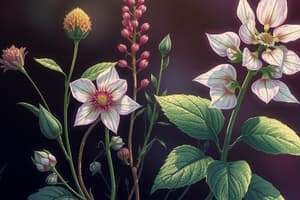Podcast
Questions and Answers
What is the primary energy source that plants use for photosynthesis?
What is the primary energy source that plants use for photosynthesis?
- Water
- Sunlight (correct)
- Carbon dioxide
- Soil nutrients
Which of the following is NOT considered a botanical discipline?
Which of the following is NOT considered a botanical discipline?
- Psychology (correct)
- Cytology
- Morphology
- Genetics
Which type of plant relies on a vascular system for nutrient and water transport?
Which type of plant relies on a vascular system for nutrient and water transport?
- Lichen
- Fern (correct)
- Moss
- Liverwort
What is the study of internal structures and functions within plants called?
What is the study of internal structures and functions within plants called?
Which of the following is a major role of plants in the environment?
Which of the following is a major role of plants in the environment?
Which of the following is considered a non-vascular plant?
Which of the following is considered a non-vascular plant?
What term describes the study of algae?
What term describes the study of algae?
What important gas do plants produce as a byproduct of photosynthesis?
What important gas do plants produce as a byproduct of photosynthesis?
What is the primary source of carbon for autotrophs?
What is the primary source of carbon for autotrophs?
Which type of heterotroph obtains nutrition directly from hosts?
Which type of heterotroph obtains nutrition directly from hosts?
Which term describes a mutualistic association between a fungus and plant roots?
Which term describes a mutualistic association between a fungus and plant roots?
What is the role of lichen in the environment?
What is the role of lichen in the environment?
What distinguishes the plasma membrane as selectively permeable?
What distinguishes the plasma membrane as selectively permeable?
What is the most abundant type of lipid found in biological membranes?
What is the most abundant type of lipid found in biological membranes?
What provides structural integrity to the protoplast of a plant cell?
What provides structural integrity to the protoplast of a plant cell?
Which statement about biological membranes is true?
Which statement about biological membranes is true?
What is the primary function of integral proteins?
What is the primary function of integral proteins?
What is included in the cytoplasm of a cell?
What is included in the cytoplasm of a cell?
What does a mature vacuole primarily contain?
What does a mature vacuole primarily contain?
What distinguishes rough endoplasmic reticulum (Rough ER) from smooth endoplasmic reticulum (Smooth ER)?
What distinguishes rough endoplasmic reticulum (Rough ER) from smooth endoplasmic reticulum (Smooth ER)?
What is the role of the Golgi Complex in the cell?
What is the role of the Golgi Complex in the cell?
Which of the following best defines cytosol?
Which of the following best defines cytosol?
What component of the vacuole is essential for cell enlargement?
What component of the vacuole is essential for cell enlargement?
What is a characteristic feature of the Golgi Complex structure?
What is a characteristic feature of the Golgi Complex structure?
Flashcards are hidden until you start studying
Study Notes
Botany
- Study of plant life.
- Covers the anatomy, physiology, genetics, and ecology of plants.
Importance of Plants
- Provide food for all organisms.
- Produce oxygen through photosynthesis.
- Vital for the water cycle.
- Create habitats.
- Source of medicine, chemicals, and dyes.
- Help recycle carbon dioxide.
Botanical Disciplines
- Morphology: Study of plant structure and development.
- Cytology: Study of cell structure and function.
- Anatomy: Study of internal plant structure and function.
- Plant physiology: Study of plant processes, including nutrition, environmental influences, and growth.
- Systematic: Classification and evolutionary relationships of plants.
- Genetics: Study of inheritance and variation.
- Phycology: Study of algae.
- Mycology: Study of fungi.
- Bacteriology: Study of bacteria.
- Plant Ecology: Study of plant communities and environmental influences.
- Biotechnology: Using biological organisms to produce useful products.
Types of Plants
- Vascular Plants: Have specialized tissues (xylem and phloem) for transporting water and nutrients. Examples include ferns, conifers, and flowering plants.
- Non-vascular Plants: Lack vascular tissues and rely on diffusion for water and nutrient transport. Examples include mosses.
Modes of Nutrition in Plants
- Autotrophs: Organisms that synthesize their own food through photosynthesis.
- Heterotrophs: Organisms that obtain food from other organisms.
Types of Heterotrophic Nutrition
- Parasites: Obtain nutrients from a host organism by direct physical contact. Example: Cuscuta (dodder).
- Saprophytes: Obtain nutrients from dead or decaying organic matter. Example: Fungi.
- Insectivorous Plants: Partially autotrophic and partially heterotrophic; trap and digest insects for additional nutrients. Examples: Pitcher plants, Drosera.
Symbioses
- Symbiotic Association: Two organisms live in close physical contact and mutually benefit each other.
Lichen and Mycorrhizae
- Lichen: Symbiotic relationship between a fungus and algae.
- Fungi provide structure and protection, while algae provide food through photosynthesis.
- Lichen break down rocks into soil, provide food for animals, and are a source of dyes.
- Mycorrhiza: Symbiotic association between a fungus and plant roots.
- Fungi increase the plant's access to water and nutrients, while the plant provides carbon for fungal growth.
Plant Cell
- Contains a plasma membrane, protoplasm, and organelles.
- Protoplasm: Includes the plasma membrane and the internal contents of the cell.
Plasma Membrane
- Boundary between living and non-living environments.
- Selectively permeable, allowing some materials to pass through while others are blocked.
- Controls material exchange and maintains the cell's internal environment.
Composition of Biological Membranes
- Lipids: Primarily phospholipids, along with fats, oils, and glycolipids.
- Amphipathic, with both hydrophobic (water-repelling) and hydrophilic (water-attracting) regions.
- Form a fluid bilayer with a hydrophobic core, making the membrane impermeable to most polar molecules.
- Proteins: Integral proteins span the membrane, while peripheral proteins attach to the membrane surface.
- Integral proteins, also known as intrinsic proteins, are responsible for various metabolic functions, including enzyme activity, transport of molecules, and cell signaling.
Cytoplasm
- Gel-like substance within the cell membrane, including the cytosol and organelles.
- Cytosol: The liquid component of the cytoplasm; separated into compartments by membranes.
Organelles
- Vacuole: Large, centrally located compartment in mature plant cells.
- Occupies 80-90% of cell volume.
- Surrounded by a membrane called the vacuolar membrane.
- Contains various substances, including inorganic ions, organic acids, sugars, enzymes, and pigments.
- Plays a role in water uptake and cell enlargement.
- Endoplasmic Reticulum (ER): A network of interconnected membranes extending throughout the cytoplasm.
- Rough ER: Contains ribosomes, where protein synthesis occurs. Proteins are passed through the membrane into the ER lumen before being transported further.
- Smooth ER: Lacks ribosomes and is involved in lipid biosynthesis and membrane formation.
- Golgi Complex: A stack of flattened, membrane-bound sacs called cisternae.
- Processes and modifies carbohydrates in glycoproteins, which are transported from the ER in vesicles.
Studying That Suits You
Use AI to generate personalized quizzes and flashcards to suit your learning preferences.




